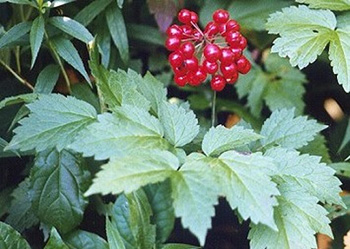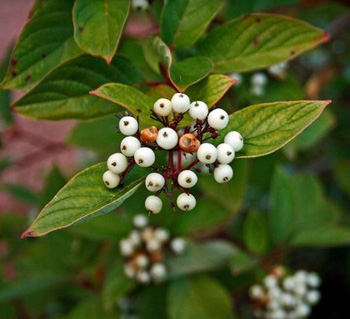Contents:
Common Names | Parts Usually Used | Plant(s) & Culture | Where Found
Uses | Warning | Bibliography
Scientific Names

- Baneberry, red
- Actaea rubra L.
- Baneberry, white
- Actaea pachypoda L.
- Buttercup family
Common Names
- Red Baneberry
- White Baneberry
- White baneberry is known as Doll’s eyes
Parts Usually Used
Root, in both red and white baneberry.
Back to Top
Description of Plant(s) and Culture

Red baneberry is a perennial;
White baneberry is a perennial,
Where Found
Found in rich woods. Southern Canada to northern New Jersey, West Virginia, west through Ohio and Iowa to South Dakota, Colorado, Utah, and Oregon.
Back to Top
Uses
American Indians used red baneberry root tea for menstrual irregularity, postpartum pains, and as a purgative after childbirth; also used to treat coughs and colds.
Menominees used small amount of white baneberry root tea to relieve pain of childbirth, headaches due to eye strain. Once used for coughs, menstrual irregularities, colds, and chronic constipation; thought to be beneficial to circulation
Warning
All parts of white baneberry may cause severe gastrointestinal inflammation and skin blisters. Its use is not recommended.
Red baneberry is poisonous. May cause vomiting, gastroenteritis, irregular breathing, and delirium. Its use is not recommended. These herbs are poisonous.
Back to Top
Bibliography
![]() Eastern/Central Medicinal Plants
Eastern/Central Medicinal Plants, by Steven Foster and James A. Duke., Houghton Mifflin Company, 215 Park Avenue South, New York, NY 10000
 How Indians Use Wild Plants for Food, Medicine & Crafts
How Indians Use Wild Plants for Food, Medicine & Crafts, by Frances Densmore, Dover Publications, Inc., 180 Varick Street, New York, NY 10014, first printed by the United States Government Printing Office, Washington, in 1928, this Dover edition 1974
